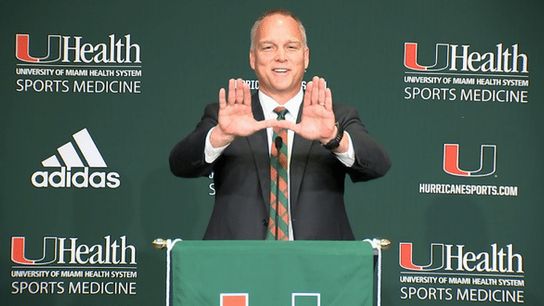I've always had a low-grade obsession with the different colors of non-contact jerseys programs dress their quarterbacks in. Oklahoma's wear blue and Texas's wear black. LSU's wear green. Clemson's wear purple. USC's wear gold.
Miami's quarterbacks typically wear the traditional red, but head coach Mark Richt removed the protective halo that special jersey provides during a Saturday scrimmage. Richt wanted his quarterback to take live punches, so to speak, and one of those punches landed on redshirt freshman Jack Allison.
Allison suffered a bruised shoulder, which Richt said was not serious. Still, amid questions of why he would subject his quarterback to hits he didn't have to take, Richt said those hit were necessary to see how Allison and his competitors would fare when the time arrived when taking hits is a necessity to play the position.
"Let’s make everything clear – I don’t ever want a guy getting hurt. But a cornerback can get hurt. A tackle can get hurt," Richt said. "A running back can get hurt. A receiver can get hurt. Everybody can get hurt. My goal is not for anybody to get hurt. My goal is to learn as much as I can about these guys, who are competing for the most important job on the team. The way we were going, I wasn’t getting a lot of clarity. If the quarterback can prove that he has mobility, he can stand in there and throw a strike when people are bearing down on him here and there, that’s part of football. If you’re a pocket passer, you’re going to get hit when you’re in the pocket. If you run, you might get hit. It’s part of football. How do guys react to that? Protection’s not good. Protection’s not good again. On the next play, protection is perfect – am I going to scramble around like a mad man, because I’m afraid my protection won’t be good the next time? There’s so many things you can learn about a guy. If you wait until Game 1, and you base your decision on everything but true reality in football, you might be making the wrong decision. Then the guy’s in there, and you realize, ‘He can’t really handle it, when the bullets are flying.’ Now I have to make a change after Game 1 or after the first quarter, I’m like, ‘Oh my gosh, he can’t handle it.’ I certainly don’t want anybody getting hurt, but I felt it was the best shot for me to learn some of the things I need to learn about these kids."
Richt put his quarterback at risk, no doubt. Allison could, in theory, have an All-Pro future ahead of him he would never realize after, in theory, taking a career-altering hit. But, as Richt alludes to above, there is also a risk of not putting your quarterback in live situations, where the downside is pumping your practice reps into a starting quarterback who can't handle playing under duress -- only you don't realize that until the lights are on.
In this situation, where Miami is looking to replace a three-year starter in Brad Kaaya and no returning signal caller has any significant experience, it seems Richt is correct to chalk a shoulder injury up as acceptable collateral as part of a necessary risk.
